Identificação de processos erosivos com geotecnologias gratuitas
DOI:
https://doi.org/10.5212/TerraPlural.v.16.2219806.023Palavras-chave:
Geoprocessamento, ravina, voçoroca, extensão de erosãoResumo
A erosão linear é um dos tipos de erosão hídrica que mais causam problemas ambientais devido à concentração de fluxos hídricos que tem grande potencial de degradação da terra. Este trabalho tem como objetivo identificar áreas de solo erodido que ocorrem na Bacia Hidrográfica do Rio Paraíso utilizando geotecnologias gratuitas através da vetorização de erosões identificadas através da análise de imagens de satélite de alta resolução espacial disponíveis gratuitamente na plataforma Google Earth. Os resultados obtidos apontam que na Bacia Hidrográfica do Rio Paraíso a maioria das erosões lineares são feições do tipo sulco, forma mais branda desse tipo de processo erosivo. Foram identificados 463 eixos de erosão, compostos por sulcos, ravinas e voçorocas. O acompanhamento temporal de imagens elucidou a origem do assoreamento identificado em trecho do Rio Paraíso próximo à rodovia MS-316. Assim, a disponibilidade de imagens de satélite de alta resolução espacial associada aos recursos disponíveis para o processamento de dados espaciais, permite analisar áreas extensas e identificar processos erosivos com maior agilidade, auxiliando na identificação das medidas a serem adotadas a fim de conter e/ou recuperar os locais atingidos por este problema ambiental.
Downloads
Downloads
Publicado
Como Citar
Edição
Seção
Licença
Copyright (c) 2022 Terr@ Plural

Este trabalho está licenciado sob uma licença Creative Commons Attribution-NonCommercial-NoDerivatives 4.0 International License.
Os autores mantêm os direitos autorais e concedem à revista o direito de primeira publicação, que permite o compartilhamento do trabalho com reconhecimento da sua autoria e publicação inicial nesta revista. Os autores autorizam a distribuição para indexadores e repositórios institucionais, com reconhecimento da sua autoria e publicação inicial nesta revista. Autores são estimulados a distribuir a versão on line do artigo (por exemplo, em repositórios institucionais ou em sua página pessoal), considerando que isso pode gerar alterações produtivas, bem como aumentar o impacto e as citações do artigo publicado.

Este obra está licenciado com uma Licença Creative Commons Atribuição 4.0 Internacional.















